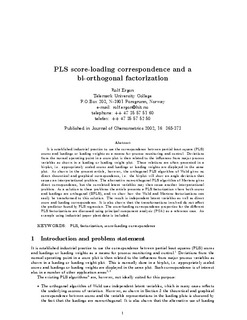PLS score-loading correspondence and a bi-orthogonal factorization
Journal article, Peer reviewed
Permanent lenke
http://hdl.handle.net/11250/2438384Utgivelsesdato
2002Metadata
Vis full innførselSamlinger
Originalversjon
Journal of chemometrics 16(2002) No. 7, p. 368-373 http://dx.doi.org/10.1002/cem.736Sammendrag
It is established industrial practice to use the correspondence between partial least squares (PLS) scores and loadings or loading weights as a means for process monitoring and control. Deviations from the normal operating point in a score plot are then related to the influences from major process variables as shown in a loading or loading weight plot. These relations are often presented in a biplot, i.e. appropriately scaled scores and loadings or loading weights are displayed in the same plot. As shown in the present paper, however, the orthogonal PLS algorithm of Wold gives no direct theoretical and graphical correspondence, i.e. the bi-plot will show an angle deviation that causes an interpretational problem. The alternative non-orthogonal PLS algorithm of Martens gives direct correspondence, but the correlated latent variables may then cause another interpretational problem. As a solution to these problems, this paper presents a PLS factorization where both scores and loadings are orthogonal (BPLS), and we show how the Wold and Martens factorizations can easily be transformed to this solution. The result is independent latent variables as well as direct score and loading correspondence. It is also shown that the transformations involved do not affect the predictor found by PLS regression. The score-loading correspondence properties for the different PLS factorizations are discussed using principal component analysis (PCA) as a reference case. An example using industrial paper plant data is included.
